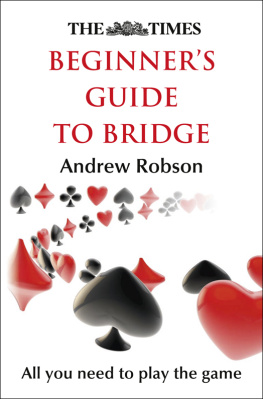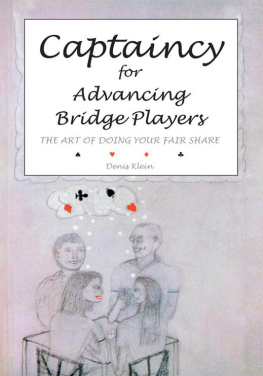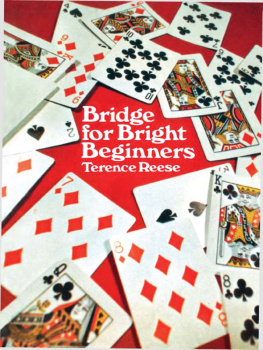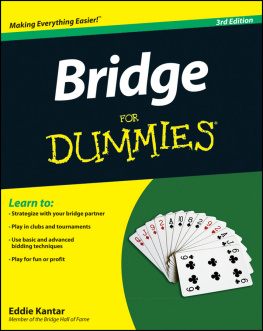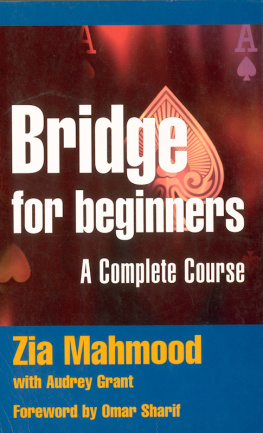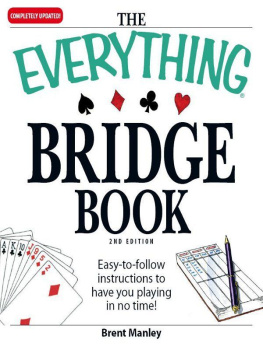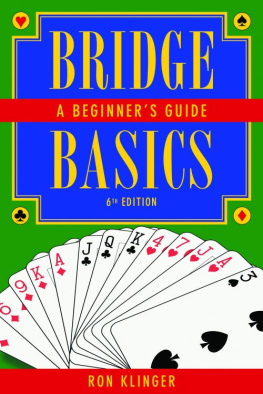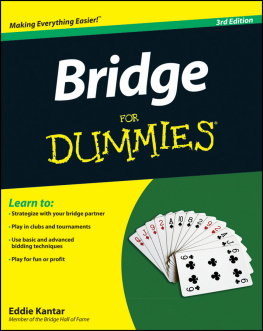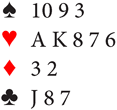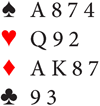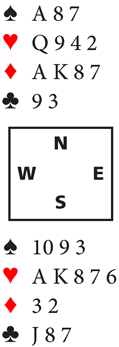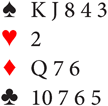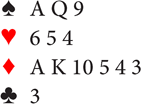Introduction
About 6 years ago Jan Van Cleeff approached me with an idea for a website: I would write, or in a few cases edit, a series of articles on bridge and they would be available for purchase on Jans website.
The website was originally named bridgetopcis.com and later became newinbridge.com. I have received lots of positive feedback from those that have acquired the articles but there is a much wider audience we hope to reach by putting the articles out in book form.
The articles have been designed for all levels of player: by starting with the basics on the topic and gradually filling in details up to expert level, I hope to frame the issues in a way all can understand and also raise issues for a partnership to discuss. If your level is more basic you might wish to digest a bit at a time, coming back for more when you feel ready.
I have selected 9 excellent topics for this first book that I know will have wide appeal, including two about conventions I invented: Support Doubles, and Serious 3NT. Topics cover some very important areas of constructive bidding, competitive bidding, and slam bidding.
My collaboration with newinbridge.com resulted in the development of a new app, uBid. This app allows you to practice bidding with your partner on a wide range of topics including the conventions I describe in this book. You are given the chance to practice your bidding on a new topic before actually using it at the table.
Practice these Bidding Topics with your partner using uBid!
Click Here
Support Doubles and Redoubles
Introduction
I invented Support Doubles and Redoubles in 1974. The original idea was that opener could double an overcall to show three-card support for responders major. For clarity, opponents bids are shown in parenthesis:
Double: three-card heart support
2: four-card heart support
Pass or other bids: fewer than three hearts
A Support Redouble applies when RHO (Right Hand Opponent), and likewise LHO = (Left Hand Opponent) makes a take-out double of the response of one of a major:
Redouble: three-card spade support
I invented this convention originally to avoid playing in a 3-3 major suit fit. At the time we played Precision, and in response to the 1 opening, I thought it clever to bid 1 or 1 on a three-card suit. My partner, Mr. Bloom, thought it was right to raise with three-card support. So, the resulting 3-3 fit I named a Bloom Obstinance Fit. One day the bidding went:
At this point my partner, after long thought, said Two Hots (hes from Boston). At this point I thought at least in competition, he can double to show three-card support. Thus the Support Double was born, though at the time I called it the Bloom Obstinance Double. It has later been renamed the Support Double.
Though I no longer respond three-card majors, the Support Double is as useful as ever. Suppose I have this hand:
Partner opens 1, RHO passes, I bid 1 and LHO bids 2. How high should I compete?
Lets first suppose that partner has passed, denying three or more hearts. In this case I know we have no eight-card fit anywhere (partner would rebid 2 with six diamonds). Thus I should pass and try for a plus on defense. Partners hand is:
We have an excellent chance to go plus against 2; 2 or other partials our way rate to go down. Put the Q in the heart suit, so that partner has:
Now it is right to compete to 2, and partner will double 2, the Support Double, to show me three-card heart support. I remove to 2. Both 2 and 2 figure to make so this is a good thing.
Now suppose partner has a fourth trump:
Partner will raise to 2 and you will pass, but if they compete to 3, you will try 3, confident that there is a nine-card fit. There is no assurance that this will always work but it is playing the percentages.
When do Support Doubles and Redoubles apply?
The short answer: when you and partner agree that they do! Regardless of what I say here, you need to discuss it with your partner. My suggestion is as follows:
Support Doubles apply through a 2 bid on openers right.
Support Doubles apply only when responder has bid 1 or 1.
It doesnt matter what openers LHO did.
Support Redoubles have only one case: openers RHO doubles the response of one of a major for take-out.
Double: Support. Responder has bid one of a major and there was an overcall on openers right that was at 2 or below.
Double: not Support. This double means whatever you have agreed: penalty, take-out, good hand, whatever.
Double: Support. Responder has bid one of a major and RHO overcalled at the one- or two-level. It doesnt matter that LHO has overcalled 1.
In the last case you might wonder: the 1 bid shows at least five spades (since most play that a negative double would show exactly four spades), so why would you need a Support Double?
It is nice to know when there is a nine-card fit vs an eight-card fit. Suppose you have this hand:
No one vulnerable:
It might work very well to bid 4 here but it might be a disaster also. Pard might have three small cards in spades with a 4-1 split. Since partner has another chance to bid, it is best to pass (in tempo). He knows you have five spades. Say opener has:
He can bid 4 himself, having strong trumps and a good side suit. If opener has:



